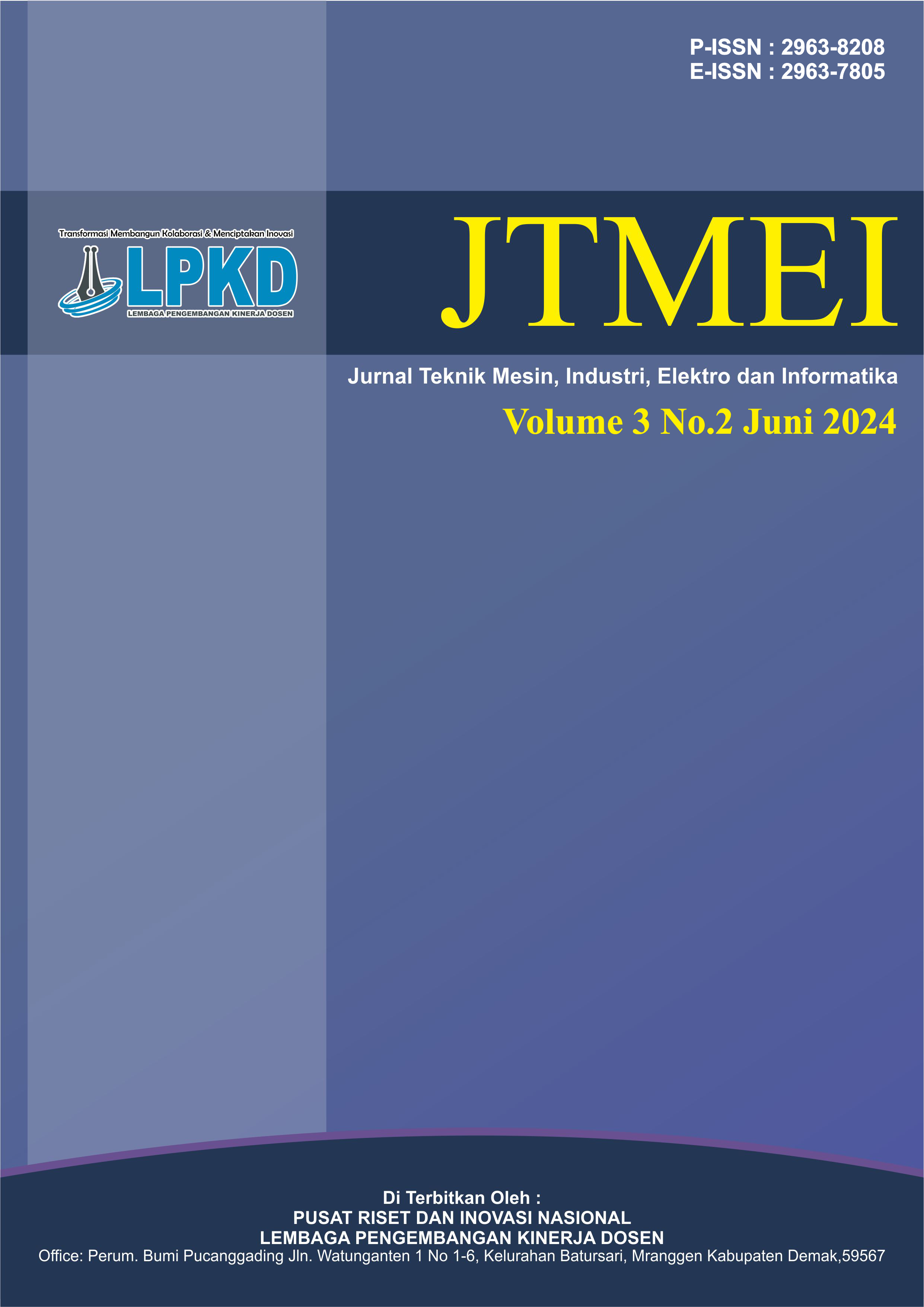Pendeteksi Kadar Asap Di Dalam Galley MT. Supreme Star Menggunakan Nodemcu ESP32
DOI:
https://doi.org/10.55606/jtmei.v3i2.3797Keywords:
Smoke Level Detector, MT. Supreme Star Galley, NodeMCU ESP32, MQ-135 Sensor, ACS712, LCD, IoT, Exhaust Fan, Part Per Million, Carbon Monoxide, LEDAbstract
This research aims to design and develop a smoke level detection device based on NodeMCU ESP32 with a room-scale ratio of 1:10. The issue at hand is the occurrence of two false alarms during sailing practices on the MT. SUPREME STAR due to the oversight of the galley Exhaust Fan activation by the cook, resulting in kitchen smoke escaping the room. The designed device is equipped with 4 MQ-135 sensors and an LCD, along with 4 ACS712 sensors to measure the smoke density in the galley in terms of ppm (Part Per Million). LED serves as a parameter for CO (Carbon Monoxide), and ACS712 is utilized to detect mA, determining whether the sensor can activate the Exhaust Fan, indicated by the detected mA. This research includes designing a device to detect smoke levels and automatically activate the Exhaust Fan, as well as understanding the operation of smoke sensors and the NodeMCU ESP32 Microcontroller. By using the "trial and error" research method, namely a series of experiments carried out repeatedly using different methods and materials. Test results indicate that the MQ-135 sensor has an average error ranging from -7.5% to +5.69%, influenced by input voltage. Additionally, IoT test results show that some sensors face difficulty in transmitting data due to voltage drop when Wi-Fi is enabLED. Overall system testing demonstrates that the device effectively controls smoke in the galley. The Exhaust Fan operates according to the predetermined program, and the LED provides an indicator of smoke opacity in accordance with the Air Pollution Standard Index. The MQ-135 sensor can prevent smoke emissions by automatically activating the Exhaust Fan when smoke levels are detected above 30 ppm. Thus, this device prototype can be a solution to address false alarm incidents, and its success indicates the potential use of MQ-135 sensors in the automation of smoke control systems in enclosed spaces.
Downloads
References
Atmadja, M. D., Soelistiant, F. A., & Kristiana, H. M. (2016). Analisis perbandingan susunan rangkaian pada lampu LED untuk penerangan. SENTIA 2016, 8(2).
Auliya, A., & Aprilia, D. N. (2017). Pengaruh hygiene pengolahan makanan terhadap kualitas makanan di Hotel Aston Rasuna Jakarta. Jurnal Hospitality dan Pariwisata, 2(2).
Budiharto, W. (2018). Panduan pemrograman mikrokontroler AVR ATMega16. Elex Media Komputindo.
Chanthakit, S., & Rattanapoka, C. (2018, July). MQTT-based air quality monitoring system using NodeMCU and Node-RED. In 2018 Seventh ICT International Student Project Conference (ICT-ISPC) (pp. 1-5). IEEE.
ESP32 technical reference manual (2023). Version 5.0 Espressif Systems.
Faroqi, A., Halim, D. K., WS, M. S., & Hadisantoso, E. P. (2017). Perancangan alat pendeteksi kadar polusi udara menggunakan sensor gas MQ-7 dengan teknologi wireless HC-05. Jurnal Istek, 10(2).
Fransiska, R. W., Septia, E. M. P., Vessabhu, W. K., Frans, W., & Abednego, W. (2013, November). Electrical power measurement using Arduino Uno microcontroller and LabVIEW. In 2013 3rd International Conference on Instrumentation, Communications, Information Technology, and Biomedical Engineering (ICICI-BME) (pp. 226-229). IEEE.
Gessal, C. I., Lumenta, A. S., & Sugiarso, B. A. (2019). Kolaborasi aplikasi Android dengan sensor MQ-135 melahirkan detektor polutan udara. Jurnal Teknik Informatika, 14, 109-120.
Githa, D. P., & Swastawan, W. E. (2014). Sistem pengaman parkir dengan visualisasi jarak menggunakan sensor ping dan LCD. Jurnal Nasional Pendidikan Teknik Informatika: JANAPATI, 3(1), 10-14.
Hernoko, M. G., Wibowo, S. A., & Vendyansyah, N. (2021). Penerapan IoT (Internet of Things) smart parking system dan pendeteksi kebakaran dengan fitur monitoring. JATI (Jurnal Mahasiswa Teknik Informatika), 5(1), 261-267.
Pratama, E. W., & Kiswantono, A. (2022). Electrical analysis using ESP-32 module in realtime. JEECS (Journal of Electrical Engineering and Computer Sciences, 7(2), 1273-1284.
Prayitno, W. A., Muttaqin, A., & Syauqy, D. (2017). Sistem monitoring suhu, kelembaban, dan pengendali penyiraman tanaman hidroponik menggunakan Blynk Android. Jurnal Pengembangan Teknologi Informasi dan Ilmu Komputer, 1(4), 292-297.
Rofiq, M., & Yusron, M. (2014). Perancangan sistem kontrol dan monitoring lampu dengan memanfaatkan teknologi Bluetooth pada smartphone Android. Jurnal Ilmiah Teknologi Informasi Asia, 8(1), 14-23.
Saleh, M., & Haryanti, M. (2017). Rancang bangun sistem keamanan rumah menggunakan relay. Jurnal Teknologi Elektro, 8(2), 87-94.
Saputra, R. D. (2022). Prototype sistem pengaturan kecepatan kipas DC otomatis menggunakan sensor PIR, sensor ultrasonik, sensor DHT11 berbasis mikrokontroler Arduino Uno dan NodeMCU. Electrician: Jurnal Rekayasa dan Teknologi Elektro, 16(1), 45-55.
Suhantono, D., & Yasa, I. M. S. (2017). Persepsi praktikan terhadap hasil desain dan pembuatan alat power supply tiga fasa menggunakan Quality Function Deployment untuk pemanfaatan praktik laboratorium elektronika Politeknik Negeri Bali. Matrix: Jurnal Manajemen Teknologi dan Informatika, 6(2), 91.
Supegina, F., & Imam, I. (2014). Pengaturan lampu taman LED RGB berbasis Arduino yang dilengkapi solar cell. SINERGI, 18(1), 9-14.
Syah, H. S., & Sungkono, S. (2021). Rancang bangun sistem pemadam kebakaran berbasis Internet of Things. E-Link: Jurnal Teknik Elektro dan Informatika, 16(2), 65-74.
Syahrinisya, V., Alini, A., & Erlinawati, E. (2022). Hubungan paparan asap pengasapan ikan dengan keluhan gangguan pernapasan pada pekerja sentra ikan salai di Desa Koto Mesjid XIII Koto Kampar. SEHAT: Jurnal Kesehatan Terpadu, 1(4), 24-31.
Tresnajaya, M. S., Partha, C. G. I., & Sukerayasa, I. W. (2020). Pemanfaatan udara buang exhaust fan sebagai pembangkit listrik tenaga bayu dengan penambahan wind tunnel berbasis Atmega 2560. Jurnal SPEKTRUM, 7(4).
World Health Organization. (2004). Carbon monoxide environmental health criteria 213 (Edisi ke-2). World Health Organization.
Yunita, P., & Hidayatulah, R. (2022). Prototype pendeteksi asap rokok dengan output suara dan SMS gateway berbasis Arduino Uno. JTIK (Jurnal Teknik Informatika Kaputama), 6(1), 77-86.
Zakariah, M. A., Afriani, V., & Zakariah, K. M. (2020). Metodologi penelitian kualitatif, kuantitatif, action research, research and development (R&D). Yayasan Pondok Pesantren Al Mawaddah Warrahmah Kolaka.
Downloads
Published
How to Cite
Issue
Section
License
Copyright (c) 2024 Jurnal Teknik Mesin, Industri, Elektro dan Informatika

This work is licensed under a Creative Commons Attribution-ShareAlike 4.0 International License.








